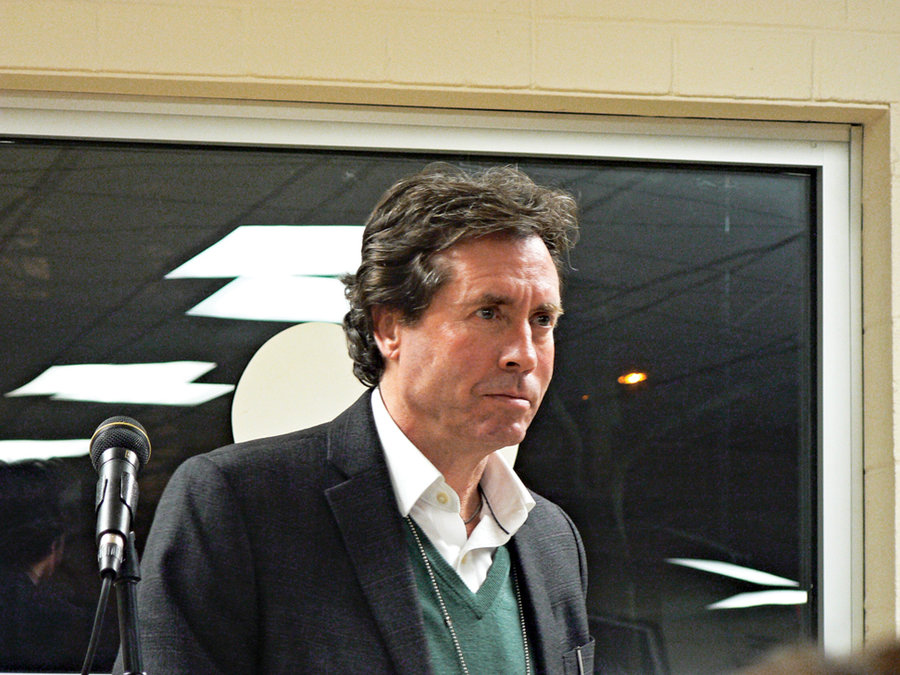Après le déluge, la bureaucratie. Some 813 days after Superstorm Sandy made landfall in New Jersey, and 232 days after a flood mitigation proposal for the Lower Hudson won $230 million in the federal Rebuild by Design competition, the relief money has yet to be disbursed to the New Jersey Department of Environmental Protection (DEP).
At a presentation to residents of Hoboken, Weehawken, and Jersey City this past Tuesday, DEP officials said the full project likely would not be complete for another 7 to 10 years.
First and foremost, DEP must submit a substantial amendment to its disaster recovery action plan to the U.S. Department of Housing and Urban Development (HUD), which holds the Rebuild by Design purse strings. A draft version of this amendment was presented at a public meeting on Tuesday, although its official public comment period closed two weeks ago.
Once the action plan is approved, a state-appointed consultant will conduct a one to two year study on the feasibility of different alternatives for flood barriers, according to Dave Rosenblatt, director of Flood Hazard Risk Reduction Measures at DEP.
“We will not be building storm surge interventions based on the last storm.” – Caleb Stratton
____________
Hoboken’s Rebuild by Design winning proposal outlines a comprehensive strategy to “resist, delay, store, and discharge” storm water, but the HUD money will likely only fund the first stage, in the form of levees or sea walls. The city is pursuing complementary initiatives, like a new wet weather flood pump for northwest Hoboken, with its own money.
After an unknown number of flood barrier options are selected, said Rosenblatt, an engineering consultant will spend two to three years designing the new infrastructure and securing permits. Construction will take another four to five years.
Too long to wait?
That timeline concerned some members of the public. Gary Holtzman, a Hoboken resident and chairman of the local Planning Board, asked that the DEP “do something to step on the gas” with its flood mitigation plans for Hoboken.
“With the timeframes that you laid out,” he added, “while they might be relatively expedited in the world of government service, us folks on the ground need a little bit more help sooner.”
DEP Deputy Commissioner David Glass, the highest ranking state official at Tuesday’s meeting, said his agency would do everything possible to identify infrastructure elements appropriate for an expedited process. The state may submit separate Action Plans for individual stages or features of the project, because they are required by federal law to spend disaster relief funds within two years of dispersal.
Mayor Dawn Zimmer said her main concern was being as prepared as possible for a flood event as big or bigger than Sandy. “It could come next spring, it could come next year, it could come in five years, it could come in ten years, but it will come again, and it was devastating for the city of Hoboken,” said Zimmer. She noted that a few more feet of water during Sandy would have knocked out the North Hudson Sewage Authority for months.
Not everyone shared her preoccupation with large flood events. “It would be a mistake to develop a plan based on what happened during Sandy,” said Ron Hine, executive director of the Fund for a Better Waterfront (FBW). “Sandy was in fact a fairly rare event, and…the flooding that we typically see in Hoboken comes with major rainstorms combined with a sewer system that is antiquated.”
Hine was particularly concerned that a massive sea wall could drastically alter the South Waterfront walkway, which his group was instrumental in bringing to fruition in the early 1990s. “If you’re on ground level at the street or the sidewalk,” he said, “or in any of the retail shops, [a wall] would completely block your view of the waterfront park, the Hudson River, and the New York City skyline.”
Jim Vance, the FBW president, similarly warned that the area around New Orleans’ levees is a municipal dead zone.
The South Waterfront was not one of the main conduits through which Hoboken flooded during Sandy.
Planning for the worst
Just how high might anti-flood barriers someday rise in Hoboken? Given the high cost of building hard infrastructure, Hoboken City Planner Caleb Stratton said any dikes or sea walls would likely be designed to withstand a much larger, even more historic storm than Sandy.
“We will not be building storm surge interventions based on the last storm, we will be looking at the 500 year flood plus sea level rise,” said Stratton.
That could mean significantly large structures. Based on water level data for the Battery in Manhattan, which is roughly equivalent to Hoboken, a 500-year storm surge—one with a one in 500 chance of happening every year—would reach a height of around 10 feet above average sea level.
With 2.5 feet of sea level rise due to climate change by 2050, the worst case scenario estimated by the New York City Panel on Climate Change, plus an extra foot or two of freeboard to account for waves or bad projections, flood walls in Hoboken could stretch 16 feet above sea level.
Philip Orton, an ocean scientist at Stevens Institute of Technology who attended Tuesday’s meeting, said this type of long-term flood planning is crucial. “In New Orleans, they always built a little bit higher than the last flood,” he said, “and they would get catastrophically flooded, and we lost over 1,000 people in Katrina.”
Orton said planning for a flood disaster must go far beyond physical improvements, even encompassing cultural changes like making sure everyone knows how to swim.
In addition to Zimmer, Weehawken Mayor Richard Turner and Douglas Carlucci, an aide to Jersey City Mayor Steven Fulop, were in attendance at Tuesday’s meeting.
Carlo Davis may be reached at cdavis@hudsonreporter.com.
